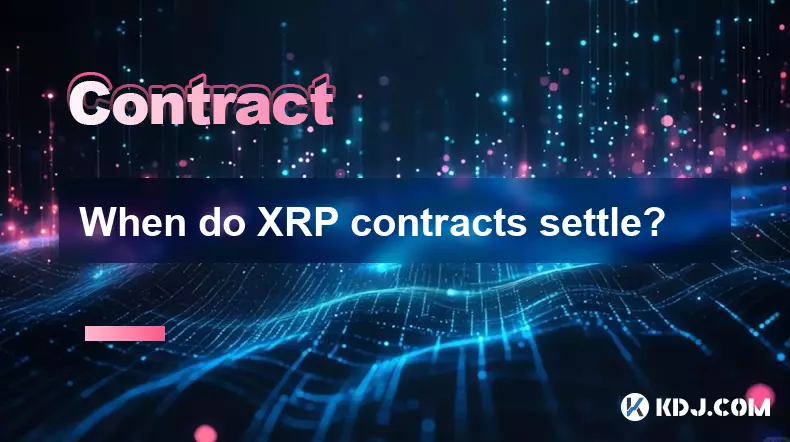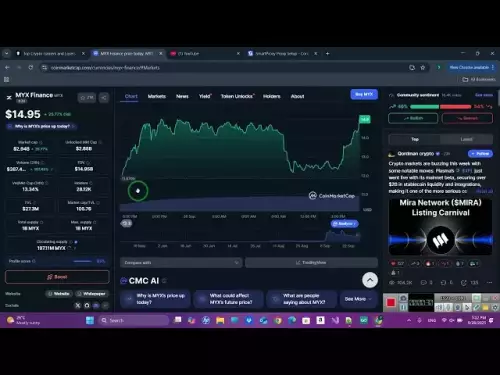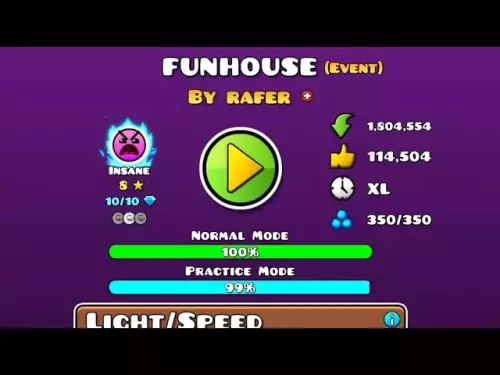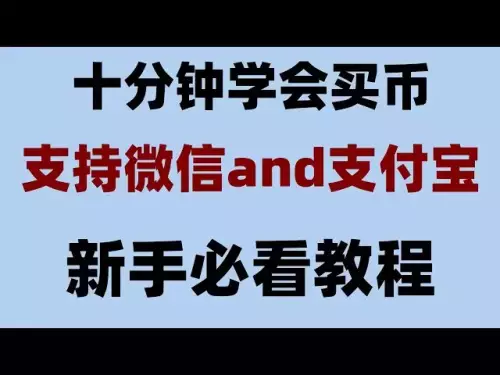-
 bitcoin
bitcoin $109547.008142 USD
0.04% -
 ethereum
ethereum $4011.838726 USD
-0.05% -
 tether
tether $1.000402 USD
-0.01% -
 xrp
xrp $2.798606 USD
0.88% -
 bnb
bnb $970.877944 USD
1.39% -
 solana
solana $202.237275 USD
-0.95% -
 usd-coin
usd-coin $0.999673 USD
0.00% -
 dogecoin
dogecoin $0.229294 USD
-1.15% -
 tron
tron $0.336370 USD
-0.45% -
 cardano
cardano $0.777260 USD
-1.66% -
 hyperliquid
hyperliquid $45.503019 USD
1.73% -
 ethena-usde
ethena-usde $1.000362 USD
0.01% -
 chainlink
chainlink $20.785303 USD
-1.10% -
 avalanche
avalanche $28.755822 USD
-0.11% -
 stellar
stellar $0.358303 USD
-0.48%
When do XRP contracts settle?
XRP contract settlements finalize in 3–5 seconds, leveraging the ledger’s fast consensus, built-in escrow, and atomic operations for near-instant, irreversible execution.
Sep 24, 2025 at 05:36 am

Understanding XRP Contract Settlement Timing
1. XRP transactions are processed on the XRP Ledger, a decentralized blockchain network designed for rapid settlement. Unlike traditional banking systems or even some other blockchains, the XRP Ledger achieves finality in seconds. Each transaction is confirmed within 3 to 5 seconds under normal network conditions, making it one of the fastest digital asset networks available.
2. Smart contracts on the XRP Ledger operate differently than those on Ethereum or similar platforms. Instead of using gas-based execution and Turing-complete code, the XRP Ledger uses atomic operations and escrow mechanisms. These functions allow conditional payments, time-locked releases, and multi-signature authorizations. Because they are built into the protocol rather than running on a separate virtual machine, these contract-like features settle as quickly as standard transactions.
3. When an XRP escrow or payment channel is created, the terms are embedded directly into the ledger state. Once the conditions are met—such as a specific date being reached or a cryptographic precondition being fulfilled—the release of funds occurs in the next consensus round. This means that settlement happens automatically and predictably, without requiring manual intervention or additional transaction fees beyond the base cost.
4. The decentralized nature of the XRP Ledger’s Unique Node List (UNL) ensures consistent validation across trusted validator nodes. Since all validators follow the same consensus rules, there is minimal risk of forks or delays in confirmation. This reliability contributes to the near-instantaneous settlement experience users expect when working with XRP-based contracts.
Factors Influencing XRP Settlement Speed
1. Network congestion has minimal impact on XRP settlement times due to the ledger’s high throughput capacity. The network can handle up to 1,500 transactions per second, which prevents bottlenecks even during periods of increased activity. As a result, contract executions remain fast regardless of overall usage levels.
2. Transaction cost plays a role in prioritization, though not in the same way as fee markets on other chains. The XRP Ledger uses a small, dynamically adjusted base fee to prevent spam. This fee is negligible—typically less than $0.01—and does not scale with demand. Contracts that include slightly higher fees may be included marginally faster, but the difference is often imperceptible due to the speed of consensus.
3. Wallet and gateway configuration can affect perceived settlement time. If a user interacts with a custodial service or exchange that batches withdrawals, the delay may occur off-chain rather than on the ledger itself. Direct use of non-custodial wallets connected to reliable nodes ensures the fastest possible path from initiation to settlement.
4. Time-based escrows depend on the ledger’s close time, which is synchronized across validators. While close times are generally within a few seconds of real time, scheduled releases might execute a few seconds after the designated moment due to rounding in the consensus clock. This precision is more than sufficient for most financial applications.
Real-World Applications of Fast XRP Settlements
1. Cross-border payments benefit significantly from rapid XRP contract settlement. Financial institutions use XRP as a bridge currency to move value between fiat systems without holding pre-funded accounts. By triggering automatic conversions upon receipt confirmation, banks reduce liquidity costs and counterparty risk.
2. Decentralized exchanges built on the XRP Ledger rely on fast-settling offers and trust lines. Users can trade assets instantly because each trade clears within seconds. Escrowed funds for large trades unlock immediately once conditions are satisfied, enabling high-frequency strategies and reducing exposure to market volatility.
3. Payroll systems for global teams utilize time-locked XRP escrows to automate salary disbursements. Employees receive their payments exactly when expected, with no intermediary delays. Employers gain transparency and auditability through on-ledger records that cannot be altered retroactively.
4. Micropayment channels leverage XRP’s low cost and speed to enable streaming payments for content creators or IoT devices. Devices can exchange tiny amounts of XRP every few seconds to pay for bandwidth or data access, with settlements finalizing before the next billing cycle begins.
Frequently Asked Questions
Q: How long does it take for an XRP escrow to release funds?A: An XRP escrow releases funds within 3 to 5 seconds after the specified condition—such as a timestamp or cryptographic key—is met and included in a validated ledger version.
Q: Can XRP smart contracts fail to settle?
A: Settlement only fails if the conditions encoded in the contract are not fulfilled. Once conditions are met and the transaction is properly signed, settlement is guaranteed by the consensus mechanism.
Q: Are XRP contract settlements reversible?
A: No. Once a contract executes and modifies the ledger state, the change is permanent and irreversible, consistent with the immutability principles of blockchain technology.
Q: Do all XRP transactions settle at the same speed?
A: Yes. All valid transactions, including those involving contract logic like escrows or payment channels, settle within the same 3- to 5-second window dictated by the ledger’s consensus interval.
Disclaimer:info@kdj.com
The information provided is not trading advice. kdj.com does not assume any responsibility for any investments made based on the information provided in this article. Cryptocurrencies are highly volatile and it is highly recommended that you invest with caution after thorough research!
If you believe that the content used on this website infringes your copyright, please contact us immediately (info@kdj.com) and we will delete it promptly.
- BlockchainFX, Binance Coin, Cardano: Decoding the Crypto Landscape in 2025
- 2025-09-29 04:45:12
- Cathie Wood, Bitcoin, and the Future of Monetary Standards: A New York Perspective
- 2025-09-29 04:25:17
- Crypto Presales Under the Microscope: BlockDAG, HYPER, and the Hunt for the Next Big Thing
- 2025-09-29 04:25:17
- Ethereum Bulls Eye $4,000: Is the Rally Sustainable?
- 2025-09-29 05:05:14
- Aster Price Surge: Bullish Breakout or Falling Wedge Fiasco?
- 2025-09-29 04:45:12
- Aptos Price Prediction: Will the Velociraptor Upgrade Trigger a Rally?
- 2025-09-29 04:50:01
Related knowledge

How do I use the scheduled order feature in Cardano (ADA) contracts?
Sep 28,2025 at 10:18pm
Understanding Scheduled Orders in Cardano Smart ContractsCardano operates on a proof-of-stakes consensus mechanism and uses the Plutus scripting langu...

How do I enable the "scalping-only" mode for Cardano (ADA) contracts?
Sep 24,2025 at 03:19am
Understanding Scalping Strategies in Crypto Derivatives1. Scalping in cryptocurrency trading refers to executing multiple short-term trades within min...

What is the settlement time for Cardano (ADA) contracts?
Sep 28,2025 at 04:18am
Understanding Cardano's Contract Settlement Mechanism1. Cardano operates on a proof-of-stake consensus model known as Ouroboros, which fundamentally i...

How do I add margin to Cardano (ADA) contracts?
Sep 27,2025 at 07:54pm
Understanding Margin in Cardano (ADA) Smart ContractsCardano operates on a proof-of-stake blockchain that supports smart contracts through its Plutus ...

What is the maximum position limit for Cardano (ADA) contracts?
Sep 23,2025 at 11:00pm
Understanding ADA Futures and Derivatives Market Structure1. Cardano (ADA) futures contracts are offered by several major cryptocurrency derivatives e...

What is the maker fee for Cardano (ADA) contracts?
Sep 26,2025 at 09:01am
Understanding Maker Fees in Cardano (ADA) Contracts1. The concept of maker fees applies broadly across decentralized exchanges and smart contract plat...

How do I use the scheduled order feature in Cardano (ADA) contracts?
Sep 28,2025 at 10:18pm
Understanding Scheduled Orders in Cardano Smart ContractsCardano operates on a proof-of-stakes consensus mechanism and uses the Plutus scripting langu...

How do I enable the "scalping-only" mode for Cardano (ADA) contracts?
Sep 24,2025 at 03:19am
Understanding Scalping Strategies in Crypto Derivatives1. Scalping in cryptocurrency trading refers to executing multiple short-term trades within min...

What is the settlement time for Cardano (ADA) contracts?
Sep 28,2025 at 04:18am
Understanding Cardano's Contract Settlement Mechanism1. Cardano operates on a proof-of-stake consensus model known as Ouroboros, which fundamentally i...

How do I add margin to Cardano (ADA) contracts?
Sep 27,2025 at 07:54pm
Understanding Margin in Cardano (ADA) Smart ContractsCardano operates on a proof-of-stake blockchain that supports smart contracts through its Plutus ...

What is the maximum position limit for Cardano (ADA) contracts?
Sep 23,2025 at 11:00pm
Understanding ADA Futures and Derivatives Market Structure1. Cardano (ADA) futures contracts are offered by several major cryptocurrency derivatives e...

What is the maker fee for Cardano (ADA) contracts?
Sep 26,2025 at 09:01am
Understanding Maker Fees in Cardano (ADA) Contracts1. The concept of maker fees applies broadly across decentralized exchanges and smart contract plat...
See all articles









































































